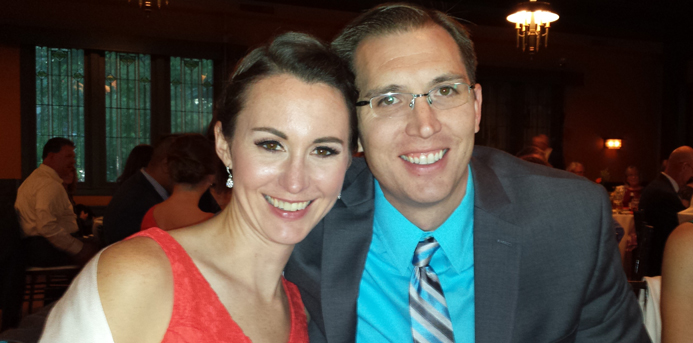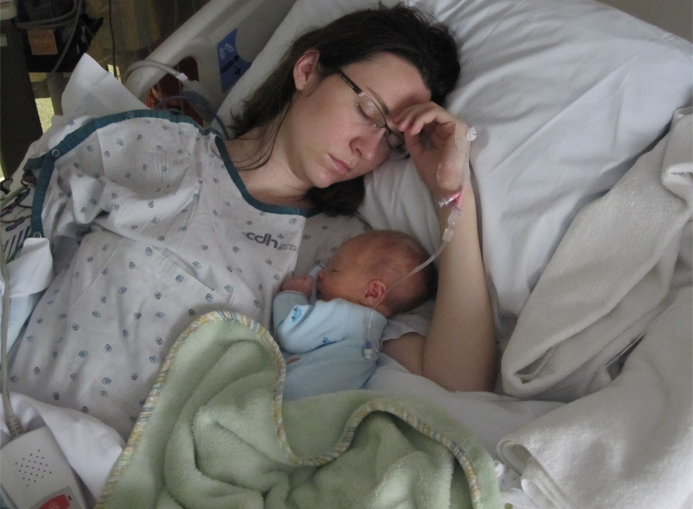Adam Kroupa and his wife, Heather, were snuggling on the bed with their newborn son, Joshua. It was their first day home together as a family.
“What do you think he’ll be like when he grows up?” Adam asked Heather.
Heather did not answer. Her eyes were wide, but she did not speak. Adam repeated the question. Heather just looked lost.
“If you don’t respond now,” Adam told her, “I am calling the ambulance.” Heather slumped over. Adam dialed 911. Would he need to raise their child on his own?
Heather was rushed to Central DuPage Hospital. At only 27 years old, she had suffered a stroke. The doctors told Adam she may never get out of bed again.
According to the Centers of Disease Control and Prevention, almost 800,000 Americans suffer from a stroke each year. Stroke is a leading cause of long-term disability. The number of women in their childbearing years who suffer from a stroke is low (11 per 100,000); however, a young woman’s risk for stroke triples around the time of delivery.
High blood pressure is the strongest risk factor for a stroke. Even without a history of hypertension, pregnant women can develop preeclampsia, a dangerous condition marked by a sudden increase in blood pressure. One of the first signs of preeclampsia can be significant and severe swelling.
One month prior to Joshua’s due date, Heather’s mother and mother-in-law, both nurses, noticed she was very swollen. They insisted she get her blood pressure checked. Heather used an automatic blood pressure machine at the Jewel, and discovered her numbers were high. When she visited her obstetrician the next day, he immediately sent her to labor and delivery. Joshua was born that night, small but strong.
After two weeks in the NICU, Heather and Adam were overjoyed to bring their son home. But the day that had been their happiest suddenly turned into a nightmare when Heather became unresponsive. While they were able to get her to a stroke center quickly and have the clot removed, the first 72 hours were terrifying for her family. Heather could not move her right arm or leg or speak a word.
Fortunately, Heather began showing signs of improvement. Soon she started moving; but she suffered from aphasia, a loss in language ability. She could not grasp or say familiar words, like her husband’s name.
After initial recovery from a stroke, the patient needs to receive comprehensive rehabilitation to regain functional independence. Adam did not know where to turn. He was accustomed to making major decisions with his wife; but now he needed to make an important one for her. A friend from church recommended the Rehabilitation Institute of Chicago.
For 24 years in a row, RIC has been voted America’s best hospital for physical medicine and rehabilitation by U.S. News and World Report. It is the only national designation for research and training on stroke rehabilitation. Researchers and clinicians work side-by-side to deliver better outcomes and recoveries.
“I really wanted Heather to be pushed hard and to be with other people actively trying to get their lives back,” Adam says. While the RIC flagship location downtown was not the closest to the Kroupas’ home in Lisle, Adam thought it was the best bet to get Heather back to the mom she wanted to be for Joshua.
At RIC, Heather underwent intensive, comprehensive physical, speech and occupational therapy. She arrived in a wheelchair, unable to speak. Not only did Heather leave two weeks later able to walk on her own, but the therapists helped her prepare for being a new mother by enabling breastfeeding and training her to walk up and down stairs with a 10-lb sack.
Standard rehabilitation centers get their patients to take 300 steps a day. RIC works diligently to increase that number to 2,500.
“We have found that by doing so, we are better able to regain the ability to walk father and faster by the time the patient returns home,” says Dr. Richard Harvey, medical director of stroke rehabilitation at RIC. Think about how much more you can accomplish if you can walk quickly and easily.
“Not being able to talk was the most difficult thing for me,” Heather says. “I wanted to communicate with my husband and read to my baby.” Heather continued her therapy at RIC DayRehab in Northbrook.
Today, it is virtually undetectable that Heather had a stroke. While she does pause to remember words or occasionally loses her train of thought, who doesn’t? She’s able to live a normal life with her family, which now includes a daughter, Allison, 2 years old. Heather is in school to become a teacher and has twice completed the SkyRise climb up the Willis Tower to benefit RIC.
The doctors at CDH were stunned when they saw Heather walking and talking again. How did she make such a dramatic recovery? “Stroke outcome is mostly dependent on rapid acute neurological care in comprehensive stroke centers along with comprehensive rehabilitation services,” Harvey says. “The process of providing coordinated comprehensive stroke care including neurological, medical and rehabilitation management is the leading factor in stroke survival and outcome.”
It is incredibly important to know the signs of a stroke so that patients can be treated quickly. Use FAST to remember the warning signs:
- F – FACE: Ask the person to smile. Does one side of the face droop?
- A – ARMS: Ask the person to raise both arms. Does one droop downward?
- S – SPEECH: Ask the person to repeat a simple phrase. Is their speech slurred or strange?
- T – TIME: If you observe any of these signs, call 9-1-1 immediately.
“If you do have a stroke, RIC is the best place for a younger person to get a full recovery,” Harvey says.
Their AbilityLab is packed with advanced technology, friendly therapists and cutting-edge researchers focused on amplifying patients’ functionality. It is the revolutionary model for RIC’s new hospital. Scheduled to open in 2017, it will focus on the outcome of increased ability as opposed to the process of rehabilitation.
Looking back, Heather wonders if she had a transient ischemic attack, a precursor the day before her major stroke. No matter how small your symptoms or how short they last, Heather recommends getting checked out.
“It might cost time and money to take an ambulance,” Heather says. “But that is far cheaper than spending weeks, months or years recovering from a stroke.”
According to the CDC, stroke has now moved down from the third leading cause of death in the U.S. to fifth. As a result of medical advancements, like at RIC, and rapid care, the risk of dying from a stroke has improved for the first year ever.



